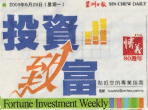 |
||
|
Home
Analysis and Media
News
WinChart
WinChart Gold
Charts Library
WinChart Way
WinChart Downloader
Our Services
Technical Support
Training Courses
Online Training
Users Testimonials
Events
Events Photos
Subscription Packages
Request a Demo
About Us
Contact Us
F A Qs
About Technical Analysis
Site Map
WinChart Forum
![]() Chinese Version
Chinese Version
About WinChart Technical Analysis
 WinChart
Technical Analysis believe in a simple but systematic method.
WinChart
Technical Analysis believe in a simple but systematic method.
First of all, chart readers must identify the major market trend movement, supports and resistance. First, draw trend lines and chart patterns, and thus outline the risk level. If unable to identify trend lines or chart patterns, apply moving average. This is to ensure that WinChart users to trade along the trend. If the major market trend is trending down, try to reduce positions, and avoid holding losing positions. At the same time, also refer to the weekly chart for a longer term perspective.
After studying the market trend, identify the trend lines or chart patterns of individual counters. Seek the important support and resistance levels. Also, refer to the weekly chart for a longer term perspective.
Apply Primary indicators like Bollinger Bands to monitor any signals. Apply moving average as a trailing dynamic support, to make sure the price is on the up trend.
Lastly, apply Secondary indicators signals for buy or sell timing. For example, when price is trending up, apply MACD bullish signal together with the price rebound at the support level. Apply WinChart RSI and Stochastic to monitor any changes of market sentiment, and watch out of any divergence warning signals. If the major market is not trending, or direction is unclear, avoid using any secondary indicators alone for trading signals.
Generally, most beginners had mistaken Technical Indicators as technical analysis, and as a result, they search for the sharpest indicators, the fastest indicators, and tune the indicators' parameters into their "perfect" indicator. Some works for a certain time, and does not work on the others, and they failed. We must understand and realized that technical indicators are always "secondary" product of stock prices, and quite often they produce wrong signals.
When price is trending, be it uptrend or downtrend, indicators signals are usually more accurate. However, when price is moving in an sideways, indecisive direction, indicators produce many whipsaws. It is quite reasonable for most beginners to pay more attention to indicators signals than anything else, for indicators signals are objectives and clear. As a result, most beginners had forgotten or had ignored the importance of trend, support and resistance.
Another common misunderstanding is that they believe in technical analysis can forecast the price movement in the future. This is, by far, the most serious misunderstanding. Technical analysis was never meant for forecast the price movement. Perhaps this is caused by some people who had, unfortunately, perceived a wrong context about technical analysis
Technical analysis is a form of statistic "poll-taking" of the price movement. It uses the past historical data to judge whether the current market condition is still favorable, thus outline the risk and potential of the current price level. Thus, reducing the unwanted risk in the uncertain market. And most of all, technical analysis help users to understand trends, and trade with the direction of the trend.
Although technical analysis does not forecast the price movement of tomorrow, it helps investors, if being used properly, by preparing them for any possible changes, thus extremely helpful in planning every trades. For example, when price formed a head-and-shoulder top patterns, chart readers will know the importance of the support at the neck line of the head-and-shoulder top. If the support is taken out, chart readers will reduce their position thus reducing the risk of holding losing position.
|
|
|
|
|
|
|
|
|
|
No. 16, Jalan LP 1A
/ 5, Lestari Perdana, | |||||||
|
Copyright © 1998-2011 Straits Index (M) Sdn Bhd. All Rights Reserved | |||||||

